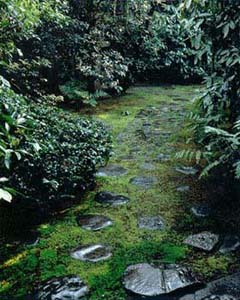| Konnichian — The Urasenke Home |
| Important Cultural Property and Historical Site |
| (Not open to the public) |
 |
 | |
| Back | Go to Menu |
 Roji
RojiThe roji garden is entered from the Mushikiken or the garden entrance which communicates with the front entrance garden. Against the garden wall is a sheltered waiting bench thought to have been designed by the fourth-generation grand master, Senso. It has a bark-shingled roof held down by a bamboo lattice and stones, a style of construction characteristic of the Kaga region where Senso frequently traveled. Because Urasenke has many tearooms, the layout of the paths through the garden and the placement of the stepping stones, seen from the waiting bench, appear very complex. The roji was skillfully laid out by Sotan with Konnichian and Yuin as the focal points. Beyond the stepping stones and a stretch of "scattered hailstones" pavement is the middle gate (chumon), with split-bamboo roof. Considered to embody Gengensai's taste, it is a famous example of a light wabi-style gate. To the left, in front of the Kan'untei tearoom, are Rikyu's beloved Kosode-no-tsukubai stone basin, and Sotan's famous stone lantern. Seen against the foliage, these present a scene conveying the tranquil mood of a mountain pathway. Passing through the middle gate and entering the inner roji, one can see the Konnichian tearoom to the left, and following the stepping stones further, one reaches the front garden of the Yuin teahouse. Set in the space between the stone water-basin and crawl-through doorway to the tearoom are the distinctive stepping stones referred to as the mamemaki ishi, "scattered-bean stones." To the right is a magnificent ginkgo tree planted by Sotan himself. Standing nearby is the well-known Rokujizo (Six Ksitigarbha Bodhisattvas) stone lantern that is said to have been presented to Sotan by HON'AMI Koetsu. Farther along the path is another waiting bench. Used as a secondary waiting bench for the Yuin tearoom, the structure features a toko alcove with a large round opening, recalling the days when it was used temporarily as a shrine dedicated to Rikyu. |